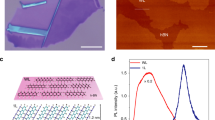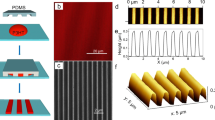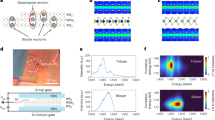Abstract
The control of exciton transport in organic materials is of fundamental importance for the development of efficient light-harvesting systems. This transport is easily deteriorated by traps in the disordered energy landscape. Here, we propose and analyse a system that supports topological Frenkel exciton edge states. Backscattering of these chiral Frenkel excitons is prohibited by symmetry, ensuring that the transport properties of such a system are robust against disorder. To implement our idea, we propose a two-dimensional periodic array of tilted porphyrins interacting with a homogeneous magnetic field. This field serves to break time-reversal symmetry and results in lattice fluxes that mimic the Aharonov–Bohm phase acquired by electrons. Our proposal is the first blueprint for realizing topological phases of matter in molecular aggregates and suggests a paradigm for engineering novel excitonic materials.
This is a preview of subscription content, access via your institution
Access options
Subscribe to this journal
Receive 12 print issues and online access
$259.00 per year
only $21.58 per issue
Buy this article
- Purchase on Springer Link
- Instant access to full article PDF
Prices may be subject to local taxes which are calculated during checkout



 for porphyrin tilting angles (θa, φa) = (− π/3,0) and(θb, φb) = (0, π/3) and magnetic field Bz > 0.
for porphyrin tilting angles (θa, φa) = (− π/3,0) and(θb, φb) = (0, π/3) and magnetic field Bz > 0.
Similar content being viewed by others
References
Davydov, A. Theory of Molecular Excitons (McGraw-Hill, 1962).
Gregg, B. A. Excitonic solar cells. J. Phys. Chem. B 107, 4688–4698 (2003).
Scholes, G. D. & Rumbles, G. Excitons in nanoscale systems. Nature Mater. 5, 683–696 (2006).
Saikin, S. K., Eisfeld, A., Valleau, S. & Aspuru-Guzik, A. Photonics meets excitonics: Natural and artificial molecular aggregates. Nanophotonics 2, 21–38 (2013).
Kippelen, B. & Bredas, J-L. Organic photovoltaics. Energy Environ. Sci. 2, 251–261 (2009).
Fidder, H., Knoester, J. & Wiersma, D. A. Optical properties of disordered molecular aggregates: A numerical study. J. Chem. Phys. 95, 7880–7890 (1991).
Mohseni, M., Rebentrost, P., Lloyd, S. & Aspuru-Guzik, A. Environment-assisted quantum walks in photosynthetic energy transfer. J. Chem. Phys. 129, 174106 (2008).
Plenio, M. B. & Huelga, S. F. Dephasing-assisted transport: Quantum networks and biomolecules. New J. Phys. 10, 113019 (2008).
Cao, J. & Silbey, R. J. Optimization of exciton trapping in energy transfer processes. J. Phys. Chem. A 113, 13825–13838 (2009).
Yoshioka, D. The Quantum Hall Effect (Springer, 1998).
Halperin, B. I. Quantized Hall conductance, current-carrying edge states, and the existence of extended states in a two-dimensional disordered potential. Phys. Rev. B 25, 2185–2190 (1982).
Wang, Z., Chong, Y., Joannopoulos, J. D. & Soljacic, M. Observation of unidirectional backscattering-immune topological electromagnetic states. Nature 461, 772–775 (2009).
Rechtsman, M. C. et al. Photonic floquet topological insulators. Nature 496, 196–200 (2013).
Hafezi, M., Mittal, S., Fan, J., Migdall, A. & Taylor, J. M. Imaging topological edge states in silicon photonics. Nature Photon. 7, 1001–1005 (2013).
Khanikaev, A. B. et al. Photonic topological insulators. Nature Mater. 12, 233–239 (2013).
Hasan, M. Z. & Kane, C. L. Colloquium: Topological insulators. Rev. Mod. Phys. 82, 3045–3067 (2010).
Qi, X. & Zhang, S-C. Topological insulators and superconductors. Rev. Mod. Phys. 83, 1057–1110 (2011).
Wang, Z. F., Su, N. & Liu, F. Prediction of a two-dimensional organic topological insulator. Nano Lett. 13, 2842–2845 (2013).
Wang, Z. F., Liu, Z. & Liu, F. Organic topological insulators in organometallic lattices. Nature Commun. 4, 1471 (2013).
Liu, Z., Wang, Z. F., Mei, J. W., Wu, Y. S. & Liu, F. Flat Chern band in a two-dimensional organometallic framework. Phys. Rev. Lett. 110, 106804 (2013).
Wang, Z. F., Liu, Z. & Liu, F. Quantum anomalous Hall effect in 2D organic topological insulators. Phys. Rev. Lett. 110, 196801 (2013).
Kim, D. (ed.) Multiporphyrin Arrays: Fundamentals and Applications (Pan Stanford, 2012).
Martinez-Diaz, M. V., de la Torre, G. & Torres, T. Lighting porphyrins and phthalocyanines for molecular photovoltaics. Chem. Commun. 46, 7090–7108 (2010).
Suto, K., Yoshimoto, S. & Itaya, K. Two-dimensional self-organization of phthalocyanine and porphyrin: Dependence on the crystallographic orientation of Au. J. Am. Chem. Soc. 125, 14976–14977 (2003).
Barrena, E., de Oteyza, D. G., Dosch, H. & Wakayama, Y. 2D supramolecular self-assembly of binary organic monolayers. ChemPhysChem 8, 1915–1918 (2007).
Brede, J. et al. Dynamics of molecular self-ordering in tetraphenyl porphyrin monolayers on metallic substrates. Nanotechnology 20, 275602 (2009).
Gao, A. et al. Two-dimensional self-assembly of a porphyrin–polypyridyl ruthenium(II) hybrid on HOPG surface through metal–ligand interactions. ChemPhysChem 11, 1951–1955 (2010).
Birnbaum, T. et al. Optical and magneto-optical properties of metal phthalocyanine and metal porphyrin thin films. J. Phys. Condens. Matter. 26, 104201 (2014).
Feyer, V. et al. Adsorption geometry and electronic structure of iron phthalocyanine on Ag surfaces: A LEED and photoelectron momentum mapping study. Surf. Sci. 621, 64–68 (2014).
Maier, S. et al. Nanoscale engineering of molecular porphyrin wires on insulating surfaces. Small 4, 1115–1118 (2008).
Scarfato, A. et al. Scanning tunneling microscope study of iron(II) phthalocyanine growth on metals and insulating surfaces. Surf. Sci. 602, 677–683 (2008).
Malley, M., Feher, G. & Mauzerall, D. The Zeeman effect in porphyrins. J. Mol. Spectrosc. 26, 320–334 (1968).
Villamaina, D., Bhosale, S. V., Langford, S. J. & Vauthey, E. Excited-state dynamics of porphyrin–naphthalenediimide–porphyrin triads. Phys. Chem. Chem. Phys. 15, 1177–1187 (2013).
Canters, C. G. & van der Waals, J. H. in The Porphyrins (ed Dolphin, D.) 531–582 Vol. 3, Ch. 12, (Academic, 1978).
Rodriguez, J. J. & Mukamel, S. Zeeman shift of two-dimensional optical signals of Mg-porphyrin dimers with circularly polarized beams. J. Chem. Phys. 137, 205102 (2012).
in Handbook of Porphyrin Science (eds Kadish, K. M., Smith, K. M. & Guilard, R.) (World Scientific, 2010).
Yao, N. Y. et al. Topological flat bands from dipolar spin systems. Phys. Rev. Lett. 109, 266804 (2012).
Yao, N. Y. et al. Realizing fractional Chern insulators in dipolar spin systems. Phys. Rev. Lett. 110, 185302 (2013).
Haldane, F. D. M. Model for a quantum Hall effect without Landau levels: Condensed-matter realization of the ‘parity anomaly’. Phys. Rev. Lett. 61, 2015–2018 (1988).
Thouless, D. J., Kohmoto, M., Nightingale, M. P. & den Nijs, M. Quantized Hall conductance in a two-dimensional periodic potential. Phys. Rev. Lett. 49, 405–408 (1982).
Knoester, J. Modeling the optical properties of excitons in linear and tubular J-aggregates. Int. J. Photoenergy 2006, 61364 (2006).
Sánchez, E. J., Novotny, L. & Xie, X. S. Near-field fluorescence microscopy based on two-photon excitation with metal tips. Phys. Rev. Lett. 82, 4014–4017 (1999).
Akselrod, G. M. et al. Visualization of exciton transport in ordered and disordered molecular solids. Nature Commun. 5, 3646 (2014).
Sheberla, D. et al. High electrical conductivity in Ni3(2,3,6,7,10,11-hexaiminotriphenylene)2, a semiconducting metal-organic graphene analogue. J. Am. Chem. Soc. 136, 8859–8862 (2014).
Zimborás, Z. et al. Quantum transport enhancement by time-reversal symmetry breaking. Sci. Rep. 3, 2361 (2013).
Lu, D. et al. Chiral quantum walks. Preprint http://arxiv-org/abs/1405.6209 (2014)
Fu, L. Topological crystalline insulators. Phys. Rev. Lett. 106, 106802 (2011).
Hsieh, T. H. et al. Topological crystalline insulators in the SnTe material class. Nature Commun. 3, 982 (2012).
Bernevig, B. A. Topological Insulators and Topological Superconductors (Princeton Univ. Press, 2013).
Feng, J., Qian, X., Huang, C-W. & Li, J. Strain-engineered artificial atom as a broad-spectrum solar energy funnel. Nature Photon. 6, 866–872 (2012).
Acknowledgements
J.Y-Z. is grateful to B. Halperin, I. Kassal, and X. Andrade for discussions, and to O. Starykh for kindly sharing his notes on the subject. All the authors would like to thank C. Laumann for discussions at the early stages of the project. J.Y-Z. and A.A-G. are supported by an Energy Frontier Research Center funded by the US Department of Energy, Office of Science, Office of Basic Energy Sciences under Award Number DESC0001088. N.Y. acknowledges support from the Department of Energy (FG02-97ER25308). Finally, S.K.S. and A.A-G. are supported by the Defense Threat Reduction Agency grant HDTRA1-10-1-0046.
Author information
Authors and Affiliations
Contributions
All authors contributed to the results presented in this Article.
Corresponding author
Ethics declarations
Competing interests
The authors declare no competing financial interests.
Rights and permissions
About this article
Cite this article
Yuen-Zhou, J., Saikin, S., Yao, N. et al. Topologically protected excitons in porphyrin thin films. Nature Mater 13, 1026–1032 (2014). https://doi.org/10.1038/nmat4073
Received:
Accepted:
Published:
Issue Date:
DOI: https://doi.org/10.1038/nmat4073
This article is cited by
-
Chiral excitonic order from twofold van Hove singularities in kagome metals
Nature Communications (2023)
-
Tunable pseudo-magnetic fields for polaritons in strained metasurfaces
Nature Photonics (2020)
-
Exploiting chemistry and molecular systems for quantum information science
Nature Reviews Chemistry (2020)
-
Topological kink plasmons on magnetic-domain boundaries
Nature Communications (2019)
-
Continuous transition between weak and ultrastrong coupling through exceptional points in carbon nanotube microcavity exciton–polaritons
Nature Photonics (2018)



